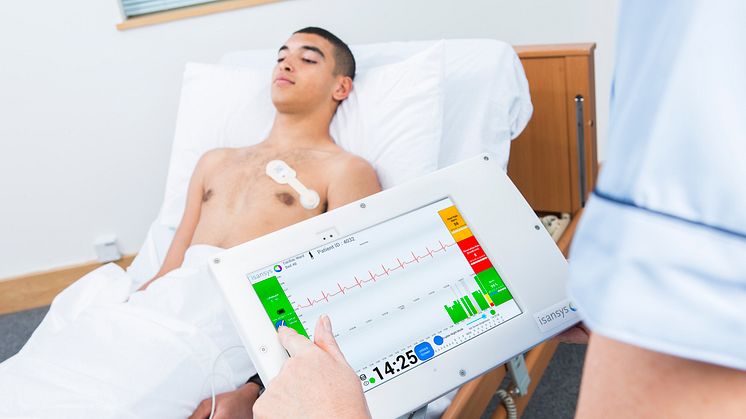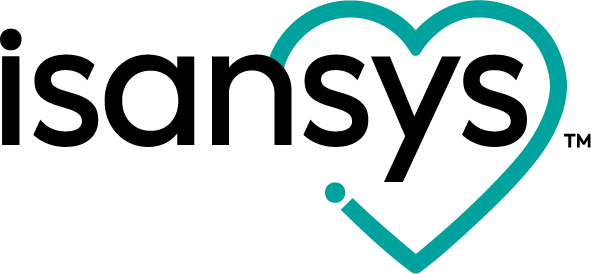
Blog post -
Precision Patient Moniting - the next generation
With hospitals now busier than ever, the demands for improved and more efficient patient monitoring have also increased. Today the number of patients per nurse continues to grow due to ever increasing patient numbers and relatively fewer nurses, and healthcare organisations globally – and particularly the NHS - now need to focus on improving efficiency and better resource utilisation in order to enable them to maintain their level of service.
It is generally recognised that the effective use of appropriate digital and ICT technologies, together with the process improvements enabled by these technologies are the keys to tackling the increasing demand / limited resources challenges facing healthcare providers. Among these are devices for directly “digitising” the patient to provide continuous and real-time physiological and associated data, and wireless technologies that provide accurate, timely monitoring and enable quality patient care whilst allowing caregivers and patients to roam freely throughout the hospital or even at home.
Isansys Lifecare Ltd has taken these latest technologies and reworked them to create a remarkable new medical product - the Patient Status Engine (PSE), an innovative, continuous, vital sign data acquisition, analysis and prediction platform that combines unobtrusive wireless wearable sensors, wireless networks, analytical algorithms and big data to provide low cost, continuous, high resolution monitoring for all patients in hospital, and at home.
This precision patient monitoring system, observing every heartbeat, every breath, oxygen saturation every second, temperature every minute and blood pressure as required allows doctors and nurses to monitor patients better, more closely, more efficiently, and continuously. It will also enable clinicians to use this automatically uploaded data to draw new insights and tailor care pathways to the needs of the individual patient.
The Patient Status Engine is suitable for, and certified for use on, patients of all ages both in hospital and in the community. It is creating considerable interest for use with paediatric patients as it offers clinical staff and patients a whole new “lead free” world in which patients are no longer connected to bedside monitoring equipment with cables, leads or wires. By utilising the data captured by the PSE, clinicians can provide the best quality of care for their patients, and ensure that every patient is treated in a timely, personal and efficient manner.
Isansys has collated the top 10 benefits of precision patient monitoring to show just how vital this new technology enabled patient monitoring is to healthcare organisations.
Top 10 benefits of precision patient monitoring:
1. Reduced adverse events and avoidable deaths
The ideal patient monitoring solution delivers both immediate and future visibility into a patient’s health status by translating the continuous real-time patient data into useful clinical knowledge through the use of data analysis methods and automated decision support tools. Clinical staff can then use that deeper knowledge to make better and more informed decisions and be alerted early to any signs of deterioration. These improved early warning indicators enable timely proactive interventions that have been shown to lead to a reduction in adverse events and avoidable deaths.
2. Improved efficiencies in the ward
The wireless and ICT technologies employed for precision patient monitoring in the Patient Status Engine provide for patient “obs” data to be acquired and uploaded continuously and automatically. This increases in-ward efficiency by freeing up nurses time and allowing them to interact with, and care for, patients without the burden of manual recording of obs data and with the comfort of knowing their patients are being closely monitored and deteriorating patients will be flagged in a timely manner. This is particularly important for high risk patients and those requiring higher frequency obs.
3. Improved patient outcomes
Early interventions that reduce the number of adverse events, emergency team responses and avoidable deaths, by definition lead to improved patient outcomes. More generally, with better information and more effective early warning indicators, clinical teams are better equipped to make better care decisions to improve patient outcomes.
4. Puts the patient at the centre of care
For the first time ever, the idea of real patient-centred care becomes possible because a patients’ physiological “image” is measured and their real-time responses to treatment collected and analysed. The key process variable (or parameter) in the healthcare process – the patient – is now being measured and the care process (pathways and work flows) can now be configured to optimise this key parameter. Until now, the data set defining the patient’s physiological image has been too sparse for this kind of optimisation.
5. Accurate data and automated mundane tasks
The Patient Status Engine providing automatic data acquisition, interactive bedside screens, real time charts at the bedside and on dashboards, integrated customisable early warning scores and large data store, enables clinical staff to:
- Minimise transcription errors at point of care
- Remotely and locally (at the bedside) configure and monitor patient’s obs and other key information
- Combine continuous obs data with other patient data
- Improve patient outcomes due to complete picture of patient’s condition
- Use aggregated data for strategic decisions and overall provider performance analysis
6. Improved staff morale
By automating a number of key tasks and monitoring many patients simultaneously via a central monitoring station, the Patient Status Engine enhances convenience and reduces effort without sacrificing quality of care. At the same time it frees up more time for caregivers to provide direct care and make better clinical decisions. Increased time at the bedside, not only improves patient care but also enhances job satisfaction and staff morale, particularly for nurses.
7. Critical care pathways extended into the home
No matter where patients are located, whether in hospital or at home, their current status, including their responses to treatment, will be immediately visible to their care team, simply by logging on to a secure portal. By enabling patients to be monitored at home, the Patient Status Engine allows care providers not only to provide their patients with superior care without leaving the comfort of their own homes, but also save money and space at hospitals and clinics.
8. Patients return home sooner
As a precision patient monitoring system, the Patient Status Engine (PSE) provides information not only on the current condition of patients but also on their trajectory into the future. Such powerful information provides the basis for more informed decisions on when to discharge patients and when to keep them in. Currently most doctors err (rightly) on the side of caution, but this often leads to bed-blocking and capacity issues. Knowing which patients are safe to discharge will lead to better bed utilisation and efficiency gains, and if any doubt remains, it is simple to send the patient home with a PSE home monitoring kit.
9. Operates as a stand-alone platform or simple integration with EHR systems
A key requirement of a precision patient monitoring system is that it populates a patient record of some kind in order to build up a long-term longitudinal view of the patient. However, many hospitals and provider groups do not yet have an electronic health record (EHR). The Patient Status Engine may be run as a stand alone system as it includes a patient information database and web-services interfaces and portal, or it may be simply integrated with an existing (or yet to be implemented) EHR system) via an open API.
10. Minimises healthcare costs
The Patient Status Engine, although a next generation medical system and a precision patient monitoring and analysis platform, is considerably less expensive than existing bedside monitoring devices and is expected to improve economic as well as patient outcomes. Providing optimal care and preventing errors can shorten hospital stays and reduce medical expenses. The Isansys platform has the potential to reduce the estimated £5 billion costs to the NHS associated with patient safety, by 30% or more. The cost of widespread adoption of the PSE is around £1 billion, leading to an annual net saving of £1-£1.5 billion
Still not convinced about precision patient monitoring?
If you’re still not convinced after reading these benefits of precision monitoring for patients, we’ll happily come and sit down with you to explain them in more detail and provide you with a free consultation on how this could help your hospital provide better care for your patients. For more information, please log onto www.isansys.com or email georgina.horton@isansys.com
Notes to editors
Members of the media interested in scheduling a briefing with Isansys Lifecare, or arranging a free demonstration of the second generation Patient Status Engine (PSE), can do so by contacting Georgina Horton at georgina.horton@isansys.com
About Isansys Lifecare Limited (http://www.isansys.com)
Isansys Lifecare is a new generation healthcare company that provides patient surveillance and monitoring services built on an innovative, low cost and scalable platform
We work with leading healthcare professionals and organisations operating in a wide range of healthcare settings, who want to employ new patient monitoring technologies and methods to improve patient outcomes and reduce costs.
Isansys’ ‘Vitals as a Service’™ clinical solution provides continuous real-time information for automated patient surveillance, for early warning scores and track and trigger indicators, and for predicting adverse events. Through its low cost and highly scalable architecture, the LifeTouch-based system offers the opportunity for continuous surveillance of all patients regardless of whether they are in hospital, other care facilities, or at home. For the first time, healthcare providers can not only cost-effectively improve patient safety and enhance clinical outcomes, but also massively reduce costs associated with avoidable patient deterioration, medical errors, readmissions to intensive care wards, and admissions (and readmissions) to hospital.

